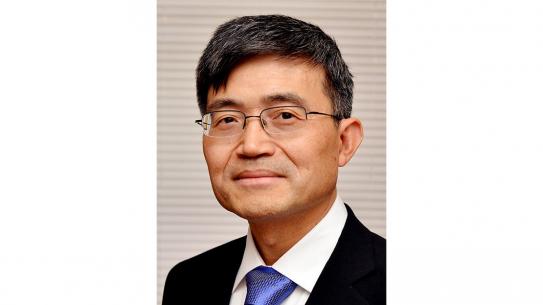A Storied Life
Professor Yoshi Okamoto Is Honored on His 90th Birthday
When Yoshi Okamoto made the lengthy ocean voyage from Japan to the U.S. in the early 1950s to attend Purdue University, he wanted to be familiar with everything that had been written by Herbert C. Brown, the renowned chemist with whom he’d be studying. Brown, who would go on to win a Nobel Prize in 1979 for his revolutionary work with boron-containing compounds, was an especially prolific writer, but Okamoto was undaunted. One problem presented itself, however; although the process of photocopying (or Xerography) had been invented in the late 1930s, commercial photocopiers did not become common until two decades later, and Okamoto had no way to easily reproduce the pages upon pages of journal articles that Brown had authored.
“There was no way, except for writing them out, word for word, by hand,” Mark Green, a Tandon professor of chemical and biomolecular engineering, explained. “And the fact that he painstakingly copied all of the journal articles he could find in the library and studied them during his almost-month-long trip to this country, tells you everything you need to know about Yoshi’s passion and intellectual curiosity.”
Greene related the tale during an auspicious event: the Polymer Reunion in Honor of Professor Yoshi Okamoto, which had been organized by Tandon colleagues and former students on the occasion of his 90th birthday and which drew attendees from around the world.
A Place in Polymer History
Okamoto is best-known at Tandon as the director of the iconic Polymer Research Institute (PRI), which had been founded by Professor Herman F. Mark in 1946. Under Mark, who is widely acknowledged as the father of polymer science, the PRI became the epicenter of the field, and anyone who wanted to seriously study polymers flocked to Brooklyn. When private companies or other universities launched their own polymer centers or programs in later years, chances were good that a scientist who had been affiliated with the PRI had helped.
The American Chemical Society (ACS) designated the PRI as a National Historic Chemical Landmark in 2003, and two years later Okamoto — who had taught at NYU’s University Heights campus before coming to Brooklyn to teach at what was then informally known as Poly — ascended to the directorship. The Institute still draws visitors from all over, many of whom are eager to take a photo of the ACS plaque and marvel at the school’s role in making polymer science a vital branch of chemistry.
More than a Scientist and Educator
As the symposium and birthday celebration made clear, Okamoto is respected for much more than his research and scholarship. Numerous speakers mentioned his energy, which has not flagged in the decades since he arrived in Brooklyn. “He is energized by his work,” Dean Katepalli Sreenivasan marveled. “He still attracts graduate students, raises his own research funds, and can be found here at the school several days a week — pursuits that many professors much younger would be tempted to forego.” Vice Dean for Research, Innovation, and Entrepreneurship Kurt Becker recalled first coming to Tandon and seeing Okamoto cheerfully and vigorously wielding a cloth to clean his lab; he discovered, much to his surprise, that the white-coated figure was not a janitor or lab assistant but an esteemed professor.
David Pine, who chairs Tandon’s Department Chemical and Biomolecular Engineering, accepted his post in 2014 and knew immediately that he wanted to collaborate with Okamoto. “I could see that he was a thorough scientist but what most impressed me was the sheer delight he took in his work,” Pine said. “It was apparent he was having a ball, and that’s the mark of a person I want to work with.”
Mary Cowman, now Associate Dean for Bioengineering and a professor of biochemistry and bioengineering, has worked with Okamoto for decades and reminisced fondly about the congenial department picnics and dinners with Okamoto and his wife, but says that the weekly lunches to which he invited her greatly impacted her life and career. “T.K. Kwei and Shiro Matsuoka (both influential polymer scientists) attended, and our group discussions were enjoyable, stimulating and transformative.”
Professor Okamoto's son, Ken Okamoto (left) and Professor Kalle Levon
While humility, optimism, mentorship, and energy were themes mentioned again and again by colleagues and former students, so, too, were Okamoto’s sense of fun and willingness to bend the rules from time to time. Arnold Gordon, who served as a research assistant in the early ‘60s, recalled once having to dispose of unlabeled flasks of rocket fuel. At Okamoto’s suggestion, members of the research group did so by hurling them against a brick wall — a highly satisfying activity until someone called the fire department to report them. (He also recalled a short-lived translation service he and Okamoto launched in an effort to make extra money: “He would first translate from the Japanese to ‘Yoshi English,’ and then I would translate into standard English,” Gordon quipped.)
Henry Mei, who earned his doctoral degree under Okamoto and who served as a master of ceremonies at the event, said, “It’s hard to overstate the contributions Professor Okamoto has made both to science and to his students. Many of us went on to wonderful careers in industry and academia thanks to him, and I hope we get to gather again in honor of his 100th birthday.”




